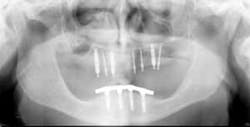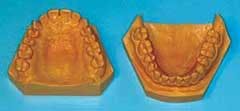Ask Dr. Christensen
In this monthly feature, Dr. Gordon Christensen addresses the most frequently asked questions from Dental Economics® readers. If you would like to submit a question to Dr. Christensen, please send an e-mail to [email protected].
For more on this topic, go to www.dentaleconomics.com and search using the following key words: informed consent, lawsuits, malpractice, diagnostic casts, postoperative care, patient records, abandonment, Dr. Gordon Christensen.
Q I have several dentist friends who have had to suffer through the threat of lawsuits over the past few years. None of them have actually had to go to trial. However, the time involvement, frustration, and embarrassment of the threatened suits took a toll on each of them. What do you recommend to reduce this increasing challenge? What are the best preventive methods in the event of a lawsuit?A You are not alone in worrying about the legal activity in dentistry! Many dentists face this worrisome problem each year. In my experience, most of the lawsuits in dentistry are not founded on actual malpractice, but on lack of informed consent about the various alternatives for specific treatment needs and inadequate documentation of diagnostic, treatment-planning, and treatment procedures. Nevertheless, they cause concern and anxiety for the practitioners involved, and some significant lawsuits are won by disgruntled patients. On the other hand, many patients who actually receive less than “standard of care” dentistry do not sue, when a lawsuit is probably indicated. You may not be that lucky.Your question is an important one, and unfortunately, only a few dentists know how to best prevent a lawsuit and what to do in the event of a threatened malpractice lawsuit. Let's discuss prevention first.
Diagnosis and treatment-planning
Each dentist has a level of diagnostic activity that he or she will accept. Some dentists have a complete diagnostic appointment, while others have superficial diagnostic appointments, obtaining only minimal information (Fig. 1 and Fig. 2). I have been involved as a consultant in numerous lawsuits in which some or all of the following negligent situations were evident:
- Inadequate radiographs, whether analog or digital, or no radiographs at all.
- Inadequate diagnostic casts that have many voids or bubbles, broken casts, discolored casts, inadequate bases on the casts, or Kennedy Class I, II, or IV cast situations that are unable to fit together when hand-held.
- Superficial health history, lacking important information such as no mention of medications taken on a routine basis, incomplete recording of past diseases, allergies, or many other points.
- No periodontal charting.
- No blood pressure recording or blood oxygenation levels recording for debilitated patients.
- No recording of previous restorations or endodontic procedures.
- Nonuse of pulp-testers.
- Missed soft-tissue lesions.
- No recording of occlusal conditions such as bruxism, clenching, abfractions, TMD, primary or secondary occlusal trauma, and numerous other pre-existing occlusal conditions.
- Lack of informed consent — Patients should be informed about all of the alternatives for their needed therapy. I suggest giving them handouts about potential therapy and the actual procedures that they are having on a given day. These handouts can be taken home and read when they are in a less stressful situation than in the dental office.
When these obvious omissions or problems are present in a threatened lawsuit, defendant dentists have little or no recourse other than to hope that the judge and/or jury believe their testimony instead of the patient's testimony. The likelihood of this happening is not good since the patient is usually considered to be the victim by those observing the case.
Occasionally, a patient will contract with a dentist to testify against the defendant dentist. This presents an even more difficult problem, since the testifying dentist knows what information and supportive clinical diagnostic aids should have been made. The defendant dentist is in trouble if adequate information and diagnostic aids are not available on the case.
Treatment
- Incomplete recording of treatment in paper or digital records is a major problem. It is too easy to record, for example, MO composite, rather than stating the type and amount of anesthetic, the brand of resin-based composite, the bond used, the expected prognosis such as “good” or “excellent,” and any other potentially useful information.
- Any suspected untoward occurrences should be stated to the patient and recorded in the patient record. As an example, if a pulp exposure or near pulp exposure has been encountered, the patient should be informed that root canal therapy is a potential outcome, and that information should be recorded in the patient record.
- Drugs prescribed are often recorded with only minimal information, and patients are given only rapid or incomplete directions on how to use the drug. When prescribing a drug, it is our professional responsibility to inform the patient about the characteristics of the drug, when to take it, how long to take it, when or when not to cease taking it, potential side effects, and any drug interactions. If a drug-related problem occurs, you are not in an unsupported situation if you have provided drug information to the patient, and if you follow up with adequate information on a problem when the patient reports it.
Postoperative care and follow-up
One of the most positive public relation acts you and I can accomplish is calling a patient at the end of the treatment day or the next day to inquire about the state of the treatment and how the patient is feeling. Personally, I prefer to call the day after the treatment to allow time for the initial trauma to subside. A well-informed dental assistant is an excellent choice for these calls. This person should be positive about the outcome of the therapy and trained to answer patient questions with accuracy.
If anything requiring potential treatment or medications is mentioned by the patient to the assistant, the dental assistant should contact the dentist immediately to avoid potential problems from occurring and any resultant patient dissatisfaction. For my personal information, I prefer to receive a short written or digital statement about each relatively complex treatment after the dental assistant has had the postoperative contact with the patient.
Standard of care
Only you know the standard of care in your community. It varies from each geographic location. Are you treating patients at or above that level? If not, get yourself re-educated and come up to the standard of care.
If you are accomplishing treatment generally considered to be within the realm of one of the seven dental specialties, your treatment will be judged legally at the level of standard of care for local specialists. The specialties and current legal activity in each are:
- Endodontics — Multirooted teeth, apicoectomy
- Oral and Maxillofacial Radiology — Misinterpretation of complex radiographs such as cone beam, tomographs, or cephalometric radiographs
- Oral and Maxillofacial Surgery — Impacted tooth removal, implant placement
- Orthodontics — Misdiagnosing or mistreating complex orthodontic needs<
- Pediatric Dentistry — Missing developing orthodontic problems, mistreating developmental problems
- Periodontics — Inadequate bone or soft-tissue grafting, lack of treatment of periodontal disease (supervised neglect)
- Prosthodontics: Fixed and Removable — Inadequate complete denture fabrication; seating and follow-up, especially mandibular; mistreated complete mouth rehabilitation with crowns, fixed prostheses, and implants
Abandonment
If you are treating a patient, and you and the patient have a disagreement, complete the treatment underway to a level of quality satisfactory to you — a level you can support in a potential legal encounter.
Occasionally, part way through treatment, such as placement of a fixed prosthesis, a patient cannot pay and treatment is postponed until the patient has the financial resources. Do not wait more than a few months or you may face a lawsuit on the basis of “abandonment,” in spite of the fact that the patient did not pay you.
To avoid a malpractice suit or to prepare for one:
- Do a complete diagnosis.
- Record your diagnostic information thoroughly.
- Educate the patient about all treatment alternatives, their advantages and disadvantages, the risks and costs of each, and what happens if you do nothing.
- Obtain a written agreement on your treatment plan.
- Treat the patient at or above your local standard of care.
- Record the treatment thoroughly.
- Follow up after treatment with genuine concern.
Recently, I made a 60-minute DVD with a well-known, mature malpractice attorney. It shows you and your staff the necessary practices to avoid a malpractice suit and what to do if you are threatened with one. The video, V4733, is titled “Protecting Yourself Against Malpractice Suits.”
Additionally, we have a new, completely rewritten booklet of patient information/practice administration forms, now in its 6th Edition, that you may use to inform patients of upcoming or ongoing treatment. Ask for BOK6, “The Dental Documents Booklet.”
For more information, visit online at www.pccdental.com or call (800) 223-6569.
Dr. Christensen is a practicing prosthodontist in Provo, Utah, and dean of the Scottsdale Center for Dentistry. He is the founder and director of Practical Clinical Courses, an international continuing-education organization initiated in 1981 for dental professionals. Dr. Christensen is a cofounder (with his wife, Rella) and senior consultant of CLINICIANS REPORT (formerly Clinical Research Associates), which since 1976 has conducted research in all areas of dentistry.


